A composite 3D model of the gatehouse turrets excavated in 2023 and 2024:
Tudor Gatehouse Turrets (Composite) by enfarchsoc on Sketchfab
Founded in 1955, the Enfield Archaeological Society is active in carrying out research and fieldwork in and around the London Borough of Enfield, in order to understand and preserve its history.
Our main aims are: to promote the practice and study of archaeology in the district; to record and preserve all finds in the borough and encourage others to allow their finds to be recorded by the Society; and to co-operate with neighbouring societies with similar aims.
Membership is open to anybody with an interest in the past.
The Enfield Archaeological Society is affiliated to the London and Middlesex Archaeological Society; the President for the society is Harvey Sheldon BSc, FSA, FRSA
 Dig With Us
Dig With UsAll members of the society over the age of 16 are welcome to dig with us – no experience is necessary. We typically run at least one dig a year in the summer, on the site of Henry VIII's Elsyng Palace with other work often cropping up through the rest of the year.
A composite 3D model of the gatehouse turrets excavated in 2023 and 2024:
Tudor Gatehouse Turrets (Composite) by enfarchsoc on Sketchfab
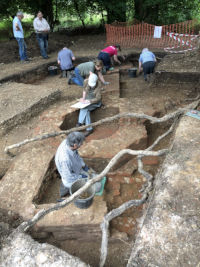
It was the final day of digging today on day 13 of our 14 day investigation of the inner gatehouse of Elsyng Palace.
Trench 2, our only remaining open trench, was thoroughly cleaned for detailed photography and fully planned by about lunchtime.
We then followed that up with methodical photgraphs of all the exposed vertical wall elevations.
There are many different walls in Trench 2 of many different phases representing multiple modifications, insertions and demolitions over its centuries long use and precisely describing and explaining them all will be a long task in post-excavation.
All the recording work was completed together with a comprehensive photographic survey by about 2pm after which we switched over to the unglamourous task of backfilling.
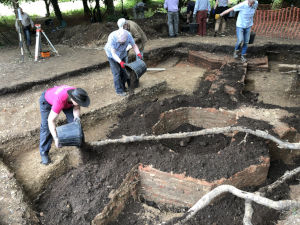
Backfilling is now the only remaining task and we hope to finish up tomorrow perhaps by about lunchtime.
A summary and eventually a report on the findings of the dig will as usual appear in future editions of Society News.
We'd like to thank our hard working members who made this dig possible and perhaps our most productive in terms of high status structure discovery since 1967. Understanding the location and layout of the inner gatehouse has been a years long effort that will go a long way to advancing our understanding of the layout of the palace, especially that of the inner court which remains largely unexplored and hidden in increasingly inpenetrable woodland.
We are also very grateful once again to Forty Hall Farm and Capel Manor College for the provision of tool storage space and the generous loan of wheelbarrows which has made our job much easier than it might have been!

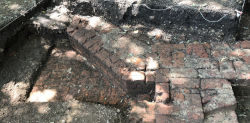
Work continued at a reduced pace today as the intense July heat finally arrived and sapped our already tired digging team's energy over the course of the afternoon.
The number of digging jobs has dwindled and backfilling continued in Trench 4 and began in Trench 3, leaving only Trench 2 active.
We finished exposing the foundation course of the wall that connects the two gatehouse turrets, and followed it to the corner of last year's turret.
The foundations here do not follow the above angular turret but are square and project from the corner (redundantly) quite a way. We think this is probably because when the foundations were laid a decision on the final shape of the turret had not yet been made.

Meanwhile the final digging task continued in the last extension to Trench 2, which was opened to follow the line of the southern facade wall of the gatehouse from our newly discovered turret, and potentially examine its junction with the internal cellar wall we confirmed the location of yesterday.
We found that wall today in the expected position as well as a continuation of the facade wall, but its interpretation and chronology is complex since there are several butt-joints at this junction, and the cellar partition wall is more substantial than it was when we found it yesterday less than 2 metres away - roughly 10cm thicker. Furthermore there seems to be a wall continuing on the same line as the cellar wall running south into the section.
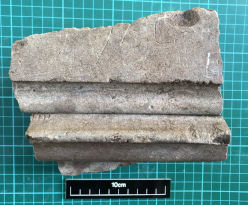
There's still a little more digging to do before it is all cleaned up and a proper interpretation made.
Yesterday digging in this spot produced numerous fragments of carved stonework including several high quality pieces that joined together to make a fragment of a Tudor arch.
The stone fragments continued to emerge today including more fragments of burning which so far have led us to believe that the stonework may be from a fireplace.
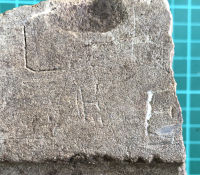
Today's star find, perhaps the star of the dig so far, was another large chunk of finely carved stone this time notable for the scratches across its flat face that on close inspection turned out to be deliberate graffiti.
There are two clearly visible capital E letters and a larger probable C. Elsewhere on the surface are much harder to see marks that might be an I or J and possibly an H. One of the Es and the C may also contain residual traces of paint.
Hopefully post excavation work will reveal more!
Tomorrow the residual digging jobs will probably be wrapped up quite quickly and we'll make a big push to fully record the turrets and connecting masonry in Trench 2 before moving over to the not insubstantial task of backfilling the trench.
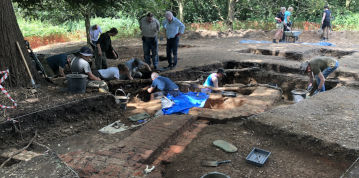
Digging continued but the pace began to wind down today as we begin to move into the recording and backfilling phase of the dig.
High temperatures also taxed our hard working diggers, who had mostly backfilled the main body of Trench 4 by the early afternoon.
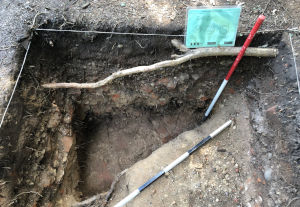
Trench 4 had originally been intended to explore the deep rubble 'cellar' fill that we found during last year's dig but failed to find it, and so an extension was laid out on day 8 to push back very close to the location of the pillar we found last year in the cellar fill, on the theory that the pillar may have been a reinforcement for the back wall of the cellar, rather than a free-standing support in the middle of it as we had supposed.
That theory appears to have been validated today, as the cut of the cellar fill, and eventually a brick wall, emerged in exactly the right spot for such a back edge to the cellar (meaning the cellar is a fair bit smaller than we'd originally thought).
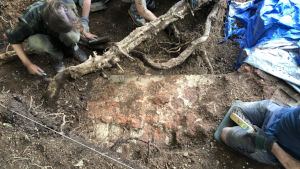
Meanwhile one final trench extension was opened to Trench 2, to reveal a little more of the south west corner of the new polygonal turret (under the pictured blue tarpaulin) and potentially pick up the junction of the wall with the back edge wall of the internal cellar, which we had freshly confirmed in Trench 4.
We progressed fairly quickly down onto the wall and by late afternoon had confirmed the cellar wall does join it where expected, albeit at a much higher level. There's a little more work to do revealing and defining these wall lines, and there may be a hint of yet another wall springing off of the gatehouses southern external side, but that has yet to be confirmed.
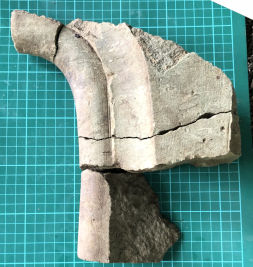
Today's star finds came from the rubble deposit immediately covering the gatehouse's southern wall, in the form of several fragments of carved stone of various sizes and some fitting together - the most notable being several joining fragments of a Tudor arch. Judging from the burning visible on several of the fragments we think this is most likely the remains of a fireplace.
Tomorrow our focus will continue to move from digging to recording and backfilling. In terms of palace structure we've probably revealed about as much as we can this year, which has been some of the most extensive and high quality building work we've seen in the past 20 years.
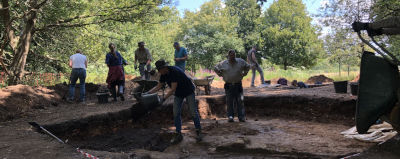
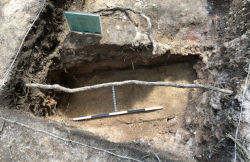
Another good day's digging today in the woods of Forty Hall as day 10 finially saw the threat of showers give way to more seasonal sunshine.
Late yesterday afternoon we finally uncovered the expected wall line in Trench 3, albeit not quite where we had expected it.
Today we finished revealing the top of the wall and clearly defining its edges.
We think this is a continuation of the facade wall on the front of the gatehouse, which meets the corner of the turret in trench 2, and which we saw part of last year.
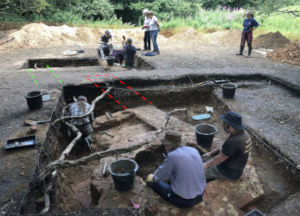
The wall is not where we had expected it, we think because there is a dog-leg somewhere between Trench 2 and 3, but is of comparable construction and certainly robust enough to be the facade of our multi-storey gatehouse.
Meanwhile in Trench 2 we removed the rest of the fill of the new polygonal turret which we had half-sectioned yesterday to fully reveal the apparent brick floor that had emerged at its base.
The limited exposure of the base yesterday had appeared to be very highly compacted bricks with virtually invisible joints with the possible exception of a patch in the south east corner which seemed to be a more loose mortar surface.
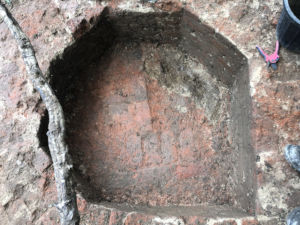
With all the fill removed and a cursory trowel-clean, the surface of bricks seems to cover most of the turret base, with wedges of rubble and mortar at some of the edges, but most notably in the south east corner, which seems at the moment to be made only of crushed brick and mortar.
It currently looks as if there might be an edge to the bricks in this corner, almost like two wall lines meeting each other rather than a deliberately laid surface, which if that is the case, might again confirm our theory that the turret is a later insertion into a pre-existing building.
The turret and adjacent walls still need a much more thorough clean and detailed recording before we can draw any firm conclusions from them, however.

Meanwhile the main features of Trench 4 were fully recorded and the main body of the trench began to be backfilled this afternoon.
The extension to Trench 4 remains open, however, which was cut to push us back towards the deep rubble context we had expected to find in Trench 4 but failed to materialize.
Finally late in the afternoon we did find the line of the cellar cut, right at the very extremity of the extension. We now suspect that the octagonal pillar feature that we found in the cellar fill last year must be located right at the very back edge of the cellar, rather than in the middle, and the cellar itself is probably not nearly as big as we assumed.
Since we've found the edge of the cellar fill we think there must also logically be a cellar wall lurking not far away and confirming this will be our next focus.
Although the process of backfilling has begun there is a lot more to do and the scope for further trench extensions is shrinking rapidly.
Tomorrow we will probably extend the Trench 4 extension to expose more of the cellar fill, possibly even joining it to Trench 2. At the same time we may make a very small extension to Trench 2 to uncover a bit more of the wall junction at the new turret's south west corner, which forms the gatehouse's southern face.
That will likely be the limit of new work for this dig, and our focus will gradually shift over soley to backfilling probably by the weekend.